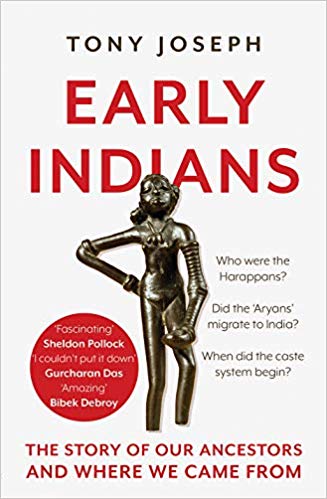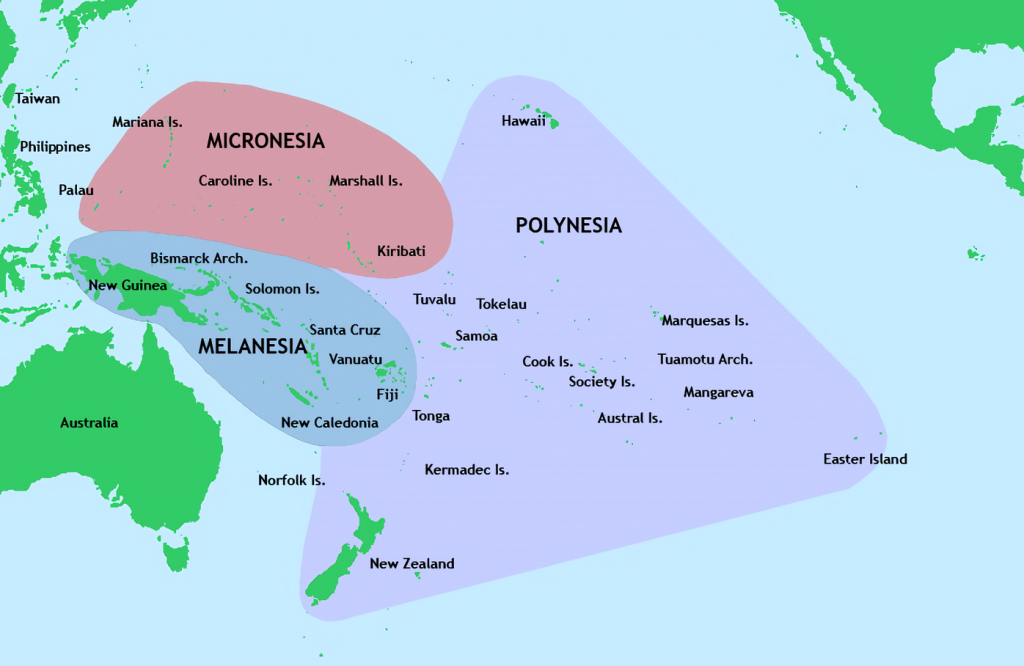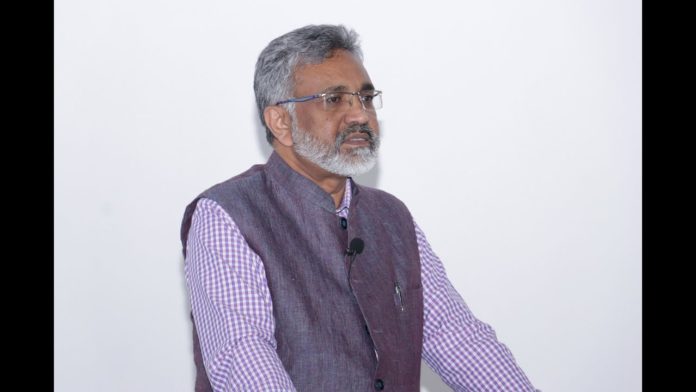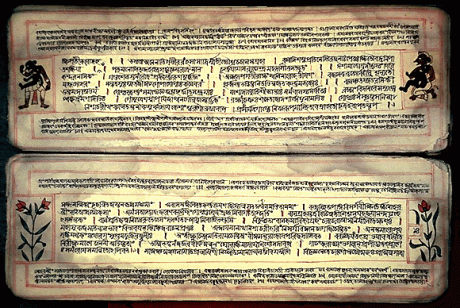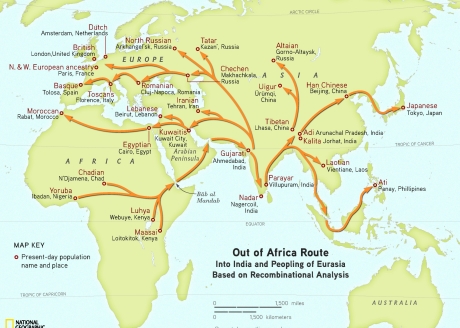Tony Joseph, a former business journalist, has published a new book titled “Early Indians: The Story of Our Ancestors and Where We Came From” [1].
Joseph is a vociferous advocate of the Aryan Invasion Theory (AIT). I have in the past debunked [2] his attempt to “settle” the AIT debate [3]. I have also debunked [4] his attempt to “answer” the question of “How We, The Indians, Came To Be” [5].
In his new book, Joseph purports to reveal the entire history of India’s ancient past and conclusively answer questions such as “Who were the Harappans?” “Did the Aryans migrate to India?” and “When did the caste system begin?”
The gist of the book can be found on page 221 where he concludes by making the following claims:
- India is a multi-source civilization.
- The genetic lineages of “Out of Africa migrants” who reached India sixty-five millennia ago form the bedrock of India’s population.
- West Asian migrants built the Harappan civilization which was associated with the Dravidian languages.
- East Asian migrants brought new languages, plants, and farming techniques to India.
- Central Asian Sanskrit-speaking Hindu Aryans were the last to migrate to India; they “reshaped” India’s society in “fundamental ways”.
In other words, Joseph’s book is a fresh attempt to re-establish the AIT as a robust theory of the origin of Hinduism and the Sanskrit language, despite an immense amount of evidence to the contrary [6].
The book’s conclusions are based upon genetic studies that have been thoroughly invalidated
The book’s findings are largely based upon paleogenomic studies conducted by David Reich and his team at Harvard Medical School.
The majority of the book’s conclusions are drawn from two studies by Reich’s team:
- A preprint (non-peer-reviewed research paper) titled “The Genomic Formation of South and Central Asia” [7] which was co-authored by 92 scientists from around the world, co-authored and co-directed by Reich, and lead-authored by a member of Reich’s team named V. Narasimhan.
- An older paper titled “Massive Migration from the Steppe was a source for Indo-European languages in Europe” [8].
The preprint (Narasimhan et al.) suffers from a number of glaring issues.
The study is based on ancient DNA from 612 individuals from various regions and periods: Iran, Turkmenistan, Uzbekistan and Tajikistan (5600-1200 BCE), the Steppe east of the Ural Mountains, including Kazakhstan (4799-1000 BCE), and Pakistan’s Swat valley (1200 BCE to 1 CE).
The study determines a total of three ancient individuals from Turkmenistan and Iran to be “Harappan migrants”, despite not having access to any actual Harappan DNA for making a genuine comparison.
The study deems these three individuals to represent an “Indus periphery” population, and since the study does not have access to any actual Harappan DNA for making a genuine comparison (a point that bears repeating), these three foreign DNA samples are made to “stand in” as “proxies” for the entire Harappan population itself!
This is the very definition of a circular argument.
The Harappan civilization had a population of over five million people at its peak. It is absurd to arrive at sweeping conclusions about its genetic make-up based on three dubious foreign DNA samples. Nevertheless, that is precisely what the study does.
Furthermore, the study makes another arbitrary and dubious assumption: it assumes the Onge tribes-people who inhabit the Little Andaman Island to be representative of what it calls the “Ancient Ancestral South Indians (AASI)”, whom Joseph refers to as the “First Indians” in his book.
This is problematic in the extreme, as it is well-known that the Andamanese people have been cut-off from the rest of humanity for several tens of thousands of years, and therefore, any genetic affinity or kinship they may have with other groups can only be distant and tenuous at best.
These are significant methodological problems that invalidate any conclusions that the study makes. It is therefore not surprising that the preprint has not been accepted for publication by any scientific journal till date.
Nevertheless, Joseph touts the Narasimhan et al. preprint as the epitome of scientific achievement and bases much of his book’s claims on it.
The older study by Reich’s team (Haak et al.) makes the dubious claim of being able to associate language (and culture) with DNA. It purports to support the hypothesis that the steppe Yamnaya culture represents the origin of Indo-European (IE) languages and culture.
The conclusions of Haak et al. are thoroughly demolished by the legendary Russian archaeologist Leo Klejn in two papers published in Acta Archaeologica [9] and the European Journal of Archaeology [10].
In the first paper, Klejn questions the circular argument the geneticists make: no-one has ever identified a Proto-Indo-European (PIE) culture, which invalidates the entire basis for the claim that massive migrations from one “home” brought Indo-European languages and culture to other regions. He raises the point that the Yamnaya culture may be Indo-Iranian or Indo-Aryan.
In the second paper, which is a discussion paper between Klejn, Reich et al. and Willerslev et al., Klejn reduces the geneticists’ arguments to complete rubble. The geneticists do not have answers to very basic questions, such as, what exactly is PIE.
There are other points:
- Archaeologically, the European Bronze Age Corded Ware culture is practically contemporaneous with the Yamnaya culture. Therefore the geneticists’ claim that the former was descended from the latter is falsified. It is more likely that branches of one people migrated to both Yamnaya and the Corded Ware, which explains the observed genetic affinity between both.
- The Yamnaya had clear contacts with the Middle Danube, so they may have given Indo-Iranian/Indo-Aryan features to Italo-Celtic languages. For example, “raja” (Sanskrit), “regis”, “rex” (Latin), “ri” (Gaelic), “rix” (Gaulish) for king. However it is unlikely that Yamnaya migrants would have reached the North of Europe, where the languages have very different characteristics: in the Germanic and Nordic languages, and even English, “raja” translates to “king” and its variants like “kong” and ”könig”.
- In the second paper, the geneticists admit “other migrations from the Steppe” (which they are unable to identify) may have brought IE languages to Europe. Apart from the repeat of the circular claim (why Steppe again?) and the lack of any basis for making this wild claim, they do not seem to have realized the really damning self-contradiction in that statement: if “other” migrations from the Steppe could have brought IE languages to Europe, that means other differentiated branches of IE were already present on the Steppe! So where did these branches originate, if they were already in a differentiated form on the Steppe, ready to launch into Europe? Could these be the people who migrated to both Corded Ware and Yamnaya, mentioned in 1?
Point 2 becomes more interesting, considering that it is a one-time historical linguistics sort of agree with archaeological observation.
Finno-Ugric languages are known to have Indo-Iranian/Indo-Aryan loanwords, but not vice versa. This would mean, only some Indo-Iranian/Indo-Aryan migrants had come to the Steppe, coming in contact with the Finno-Ugric speakers, leaving the bulk of the Indo-Iranian/Indo-Aryan speakers behind.
Also, as the loanwords in Finno-Ugric are not from PIE, but from one specific daughter branch, PIE speakers were clearly not present on the Steppe. The parsimonious explanation for all this is, the home of IE was well to the south of the Steppe (in other words, India).
From the above, it is clear that the genetics-based arguments of Reich and his team, which form the basis of Joseph’s book, are completely and thoroughly invalidated.
Understanding Reich’s deeply flawed research methodology
Imagine that a team of geneticists undertakes a study to determine the ancestry of the people of North America using only genetic evidence. They collect ten bone samples that are up to four centuries old from one archaeological site.
DNA is extracted from the samples. It is analyzed, and the samples are determined to represent individuals who belonged to three separate ethnic groups: French, English, and Africans.
Based on these results, the team declares that modern North Americans are descended from a “sex-based admixture” of French, English, and African people.
This conclusion is patently incorrect because it is well-known that the Americas were settled by Indigenous Americans at least 13,000 years ago, and European colonization did not begin until 1498.
So, what did the geneticists do wrong?
Firstly, they used a very small number of samples (ten) to deduce the ancestry of the people of an entire continent.
Secondly, they studied samples taken from a single archaeological site, which represents an infinitesimal pin-point in a continent that covers an area of nearly 25 million square km.
Thirdly, they studied samples that are only up to 400 years old.
Should they not have looked for a larger number of samples from different archaeological sites spread across the continent? Should they not have looked for older samples – samples that are 1,000 years old? 2,000 years old? 10,000 years old?
Is it not possible that by looking further back in time and in different geographical locations, they would have found vastly different genetic results?
Should they have not tried to verify whether their findings are consistent with known archaeological evidence?
These fictional geneticists’ methodology is reminiscent of the ancient Indian parable of the blind men and the elephant, where each blind man feels a different part of the elephant’s body, and comes to an incorrect conclusion about the nature of the elephant based on incomplete, limited knowledge.
Why did the geneticists make such glaring mistakes? Why did they not seek to look at the bigger picture? Were they novices, not yet well-versed in the best practices of their craft?
What if they weren’t? What if they are the world’s pre-eminent team of geneticists, equipped with the world’s best laboratory and with access to vast amounts of funding?
What if they deliberately excluded samples older than 400 years from their study? What if they were motivated by a racist, Eurocentric worldview that led them to seek to deny the existence of Pre-Columbian Native American civilizations?
A brief history of Eurocentrism, racism, and white supremacism
As Europe colonized, subjugated and devastated the Americas, Asia and Africa over the past five centuries or so, it became immensely wealthy while the rest of the world sank into poverty and despair. With immense wealth came a sense of immense superiority which manifested itself in the form of Eurocentrism, racism and white supremacism. White skin came to be considered superior, dark skin inferior. European languages and culture came to be regarded as being refined and superior, whereas subjugated peoples came to be viewed as having no culture or history.
Consider the French explorer, naval officer, botanist and cartographer Jules Sébastien César Dumont d’Urville (23 May 1790 – 8 May 1842) who explored Antarctica as well as much of Oceania. He arbitrarily classified the people of Oceania into three broad categories, a scheme that persists till today: light-skinned Polynesians who inhabit the Eastern Pacific, Micronesians who inhabit “small islands” north of the equator, and black-skinned Melanesians who live in Papua New Guinea and islands close to it.
Europeans came to imagine the lighter-skinned Polynesians as a kind of aristocracy, whereas the black-skinned Melanesians were considered to be naturally backward.
When it came to the question of their origins, a consensus emerged that the black Melanesians originated in nearby Papua which is inhabited by “savage” and “backward” black tribes, whereas the lighter-skinned, more “advanced” Polynesians must have originated in Asia, wherefrom they undertook long, arduous, heroic voyages to reach and populate the farthest Eastern Pacific islands.
The underlying assumption was that dark skin was inferior to lighter skin, and that superior culture, technology, and social structures were inextricably linked to migrations of superior, civilizing peoples from far-away lands.
European colonialism was therefore justified as being part of the natural order of things wherein superior, enlightened, lighter-skinned peoples undertook heroic voyages to new lands and acted as a civilizing influence on inferior, savage, darker-skinned natives.
Such racist attitudes persist well into the present day, in various spheres of life, and will continue to exist until the rest of the world recovers economically and decolonizes culturally.
In the academic field, this is evident in a Eurocentric approach to world history, and a patronizing attitude towards Asian and African culture, societies, and history – something that Edward Said is credited with first drawing attention to in his book “Orientalism“.
Consider the similar arbitrary classification of Indians into descendants of superior, civilizing white-skinned Aryans and inferior, dark-skinned Dravidians, a scheme that was first proposed by the German orientalist Max Müller in the 19th century. This scheme has also persisted to this day. It drives the mainstream narrative of how India’s population and civilization originated and evolved, despite an immense amount of evidence to the contrary.
Joseph’s book is an attempt to perpetuate the Aryan Invasion Myth and its insidious 21st-century mutation: the Aryan Migration Myth.
Academic racism and David Reich
On March 23, 2018, David Reich wrote an essay in the New York Times, promoting his new book “Who We Are and How We Got Here: Ancient DNA and the New Science of the Human Past”. The essay was titled “How Genetics Is Changing Our Understanding of ‘Race’” [11]. In this essay, Reich re-ignited an old controversy about race, genetics and IQ, which hearkens back to the days of the Third Reich and the racist Nobel-prize winning scientists William Shockley, James Watson and Francis Crick.
Reich wrote:
“Is performance on an intelligence test or the number of years of school a person attends shaped by the way a person is brought up? Of course. But does it measure something having to do with some aspect of behavior or cognition? Almost certainly. And since all traits influenced by genetics are expected to differ across populations (because the frequencies of genetic variations are rarely exactly the same across populations), the genetic influences on behavior and cognition will differ across populations, too.”
And:
“I have deep sympathy for the concern that genetic discoveries could be misused to justify racism. But as a geneticist I also know that it is simply no longer possible to ignore average genetic differences among ‘races.’”
In other words, Reich revealed himself to be a proponent of the arbitrary, superficial, pseudo-scientific and racist concepts of “race” and “racial differences”, which derive their origins in pseudo-sciences such as phrenology and dubious classification schemes such as the ones d’Urville and Müller proposed.
As a scientist myself, here’s what I can tell you: Race is a social construct, not a scientific fact. There is no such thing as a “pure race” or ethnicity. In fact, it is increasingly becoming clear that there is not even such a thing as a pure species.
Reich’s essay prompted 67 prominent scientists, scholars and researchers to write an open letter [12] in response to his claims. The letter says:
“(Reich) misrepresents the many scientists and scholars who have demonstrated the scientific flaws of considering ‘race’ a biological category. Their robust body of scholarship recognizes the existence of geographically based genetic variation in our species, but shows that such variation is not consistent with biological definitions of race. Nor does that variation map precisely onto ever changing socially defined racial groups.”
And:
“Reich critically misunderstands and misrepresents concerns that are central to recent critiques of how biomedical researchers — including Reich — use categories of ‘race’ and ‘population’.”
This isn’t Reich’s only brush with controversy. He is infamous, for example, for obliquely disparaging Hinduism and comparing it with Nazi ideology in the same essay.
There are also long-standing, persistent claims that Reich is associated with highly influential genetics blogs such as Dienekes’ Anthropology, West Hunter, Dispatches from Turtle Island, and the Eurogenes Blog, all of which enforce a distorted Eurocentric version of human prehistory, support theories that deeply undermine many indigenous peoples (such as in the Americas), and support the Aryan Invasion Theory in guarded forms.
Reich isn’t alone in this: It is well-known that many geneticists, linguists, and other experts both read and comment, usually under pseudonyms, on these blogs.
How ancient DNA research systematically distorts the truth
An article published earlier this year in the New York Times [13] blew the lid off a shocking scandal in paleogenomics. David Reich figures as a central character in this scandal.
The article reveals extremely troubling facts about how ancient DNA research is done. It reveals that:
- There is extensive collaboration to the point of collusion between three well-funded and well-connected labs that dominate the field of paleogenomics, in a manner that harms their competitors. These labs are the Department of Genetics, Harvard Medical School (David Reich), the Department of Genetics, Max Planck Institute for Evolutionary Anthropology, Leipzig, Germany (director: Svante Pääbo), and the Department of Archeogenetics, Max Planck Institute for the Science of Human History, Jena, Germany (director: Johannes Krause).
- Small labs are unable to compete with the Big Three because they lack access to the datasets that would enable them to place their work in the context of the bigger picture. The only way to get access to the data is to give their samples to Reich or one of the other two teams, in return for being added to the list of contributors of their research paper.
- The Big Three labs function as an oligopoly. Their power extends to funding, samples, data, and even technology. They have marginalized all competition and their dominance of the field leaves researchers and archaeologists with no option but to submit samples to them in return for a token junior authorship.
- Samples are routinely procured by extremely dubious means, often violating ethical norms. This has created a “smash and grab” culture among archaeologists in which hopeful co-authors source their bones by any means necessary, even under false pretenses. Among teams at work on any given excavation, it takes only a single colleague to deliver a bone to one of the industrial giants for the entire group to lose control of their findings. Ancient specimens in museums, too, are being swept up by these perverse incentives.
- It isn’t unusual for junior authors to be given just days to review a finished manuscript, with little input into its broader framing.
- This has created an atmosphere of intense suspicion, anxiety and paranoia, among archaeologists and geneticists alike. In dozens of interviews with practitioners of both disciplines, almost everyone requested anonymity for fear of professional reprisal.
- Reich and his team are accused by an ancient-DNA researcher in Turkey of seeing the rest of world as the 19th-century colonialists saw Africa — as raw-material opportunities and nothing else.
- Reich is shown to repeatedly arrive at broad, grandiose, sweeping conclusions about ancient migrations, invasions and wholesale replacements of one population by another on the basis of flimsy and dubious evidence – in one case, on the basis of a single sample from a single island – and often uses different, unrelated, arbitrary population groups as stand-in proxies for modern populations whose DNA samples he is unable to procure.
- Reich’s team makes “disproportionate or even wholly unwarranted claims on the basis of both the archaeological and genetic evidence it provides”.
- Reich and his team invariably express absolute certainty about their inferences and conclusions and presume to offer the final word on the ancestry and history of entire regions and cultures. They do not consider the possibility that their inferences could have been skewed by biases and faults in the set of assumptions that are inherent in their complex statistical models. Their paleogenomic papers, which are riddled with assumptions that are often weak, tenuous or outright unwarranted, end up being interpreted as fact. (What the New York Times article does not reveal is that once published, Reich’s papers are immediately taken up and politicized by blogs such as Eurogenes, West Hunter, etc.).
- There is a shocking nexus between Reich and the journal Nature, which is the world’s pre-eminent scientific journal, as well as other scientific journals. Nature is shown to violate long-established peer-review norms and standards when dealing with Reich’s papers. Nature’s actions demonstrate clear favoritism toward Reich’s work.
- For example, Nature allowed Reich, against its own norms, to revise and resubmit a paper that was rejected by reviewers (rejections are final, papers that are rejected are not allowed to be resubmitted).
- Reich resubmitted his paper on the basis of flimsy new evidence. The revised paper addressed very few of the reviewers’ concerns. Nevertheless, Nature’s editors overruled the reviewers’ steadfast objections and accepted the paper. Editors overruling a peer-review panel is unheard of.
- Nature’s preferential treatment of Reich and his team is demonstrated by the fact that other researchers and teams that arrived at the same conclusions as Reich, but by different means, had their papers inexplicably rejected, which defies logic and justice.
- The journal Current Biology accepted a paper by Reich’s team just one week after it was submitted. Peer review and acceptance of a scientific paper in a week is an unprecedented feat, unheard of even among low-quality scientific journals. It is unheard of even among low-quality scientific journals. It takes a lot of time to review a scientific paper – typically several months – as any scientist can attest. The acceptance of a complex genetics paper in just one week is absurd to the point of being ridiculous. It is a red flag that raises the very real specter of possible scientific misconduct and/or corruption.
These are but a few of a large number of extremely serious and troubling revelations in the New York Times article.
These revelations establish a case of possible ongoing scientific misconduct and raise serious doubts about the veracity of the entire corpus of Reich’s research. They demonstrate that the glaring issues in Reich’s papers that support the AIT are repeated throughout the entire corpus of his and his team’s research.
The New York Times revelations indicate the need to critically re-examine every single research paper published by Reich and his team.
They invalidate all conclusions drawn on the basis of Reich and his team’s research. They invalidate Reich’s studies purporting to support the Aryan Invasion Theory. They invalidate the entire basis for Joseph’s book.
Most importantly, the New York Times article reveals that there is an ongoing, concerted effort between influential, well-connected geneticists and some of the world’s leading scientific journals to keep perpetuating distorted, racist, Eurocentric narratives of human prehistory, including the colonial Aryan Invasion Theory.
A global neo-colonial nexus revealed
Racist, Eurocentric distortions of history are invariably targeted at disadvantaged cultures and developing nations that are recovering from recent colonization. Such distortions misinform and mislead formerly colonized people by portraying their culture in a variety of negative ways.
This leads to the gradual erosion of native culture and creates artificial divisions in the targeted societies, which makes them amenable to exploitation by an assortment of foreign, typically Western (but of late, Middle Eastern and even Chinese) neo-colonial forces.
It is therefore correct to view the act of distorting history as an act of neo-colonial aggression.
India’s left-secular-Nehruvian establishment, which has been reduced to grasping at straws to remain relevant in a nation that is increasingly confident and self-aware, has found common cause between its Hinduphobic revisionist agenda and the racist, Eurocentric agenda of Western academics such as David Reich.
Both agendas seek to portray Hinduism and Sanskrit as being foreign to India. Both seek to disparage, denigrate, and erode India’s millennia-old, incredibly varied, harmonious, and tolerant indigenous religious system and culture. Both seek to create artificial schisms within India’s society in order to make it amenable to exploitation by neo-colonial forces.
The Indian left-secular-Nehruvian establishment has been increasingly leaning on David Reich’s distorted research of late, a salient example of which is a scarcely coherent article by someone named Kai Friese wherein he indulges in character assassination of an entire team of Indian scientists on Reich’s behalf.
In my rebuttal to Friese’s article, I wrote about a hidden nexus [14] between India’s Marxist academia, left-secular ecosystem, Western academics, and India’s mainstream media.
Joseph’s book is an unmistakable sign of this nexus in action.
The New York Times article has ripped the cover off this nexus and revealed some of its global contours.
Conclusion: Joseph’s book sells racist, Eurocentric lies about Indian history based on thoroughly discredited research
To summarize, we have the following:
- Glaring issues, circular logic, dubious, arbitrary and unwarranted assumptions and severe methodological problems in David Reich’s studies that support the Aryan Invasion Theory.
- Two papers by the legendary Russian archaeologist Leo Klejn that thoroughly and conclusively lay bare and demolish the weak assumptions, flawed methodology, and conclusions of Reich’s pro-AIT research.
- Documented proof of Reich’s racism and Eurocentrism.
- A damning New York Times article that exposes shocking malpractices in the ancient DNA research ecosystem, reduces Reich’s scientific reputation to dust and discredits nearly every piece of research he and his team have published.
The above evidence, taken together, invalidates every single conclusion presented by Tony Joseph in his book.
Joseph’s book is riddled with outright false claims (pages 9, 10, 88 – Sanskrit was brought to India sometime after 2000 BCE by migrants who called themselves “Aryans”. Really?! Where’s the evidence?), circular logic, unnecessary ambiguity, idle speculation, sly dissembling, misinterpretations, misrepresentations, false claims and conclusions, fake news, references to pizza, extensive, repeated Reich quotes, especially about “extraordinary hierarchies and imbalances in power”, references to Ambedkar, references to the “ankles of Indian society”, references to the Manusmriti, and outright, utter nonsense at times.
The illogic is so severe at times that the book reads almost as if it were written with the help of David Reich himself.
But most importantly, and this bears repeating, Joseph’s book is based on Reich’s incorrect, flawed, distorted, racist interpretations of prehistory that have been thoroughly and utterly invalidated.
Joseph’s book is a calculated, calibrated neo-colonial enterprise that was conceived, designed, and launched with a singular purpose in mind: to revive the discredited Aryan Invasion Theory and thereby mislead Indians and alienate them from the truth about their history.
Be warned, dear reader. Do not allow yourself to be misled.
Acknowledgments
The author would like to thank Dr. A. K. Suri for bringing the Klejn papers to his notice and providing an excellent summary. The author would like to thank M. D. and G. L. for insightful discussions.
References
- Joseph, T. Early Indians: The Story of Our Ancestors and Where We Came From. Juggernaut (2018).
- Chavda, A. L. Propagandizing the Aryan Invasion Debate: A Rebuttal to Tony Joseph. IndiaFacts.Org (22-06-2017).
- Joseph, T. How genetics is settling the Aryan migration debate. TheHindu.Com (16-06-2017).
- Chavda, A. What Reich’s Study Says And Doesn’t About How Indians Came To Be. SwarajyaMag.Com (20-04-2018).
- Joseph, T. How We, The Indians, Came to Be. TheQuint.Com (03-04-2018).
- Chavda, A. L. Aryan Invasion Myth: How 21st Century Science Debunks 19th Century Indology. IndiaFacts.Org (05-05-2017).
- Narasimhan, V. et al. The Genomic Formation of South and Central Asia (2018). doi: https://doi.org/10.1101/292581
- Haak W. et al. Massive migration from the steppe was a source for Indo-European languages in Europe. Nature (2015). doi: https://doi.org/10.1038/nature14317
- Klejn, L. S. The steppe hypothesis of Indo-European origins remains to be proven. Acta Archaeologica 88,1,193-204 (2017). doi:10.1111/j.1600-0390.2017.12184.x
- Klejn, L. S. et al. Discussion: Are the Origins of Indo-European Languages Explained by the Migration of the Yamnaya Culture to the West? European Journal of Archaeology, 21(1), 3-17. doi:10.1017/eaa.2017.35
- Reich, D. How Genetics Is Changing Our Understanding of ‘Race’. NYTimes.Com (23-03-2018).
- Kahn, J. et al. How Not To Talk About Race And Genetics. BuzzFeedNews.Com (30-03-2018).
- Lewis-Kraus, G. Is Ancient DNA Research Revealing New Truths — or Falling Into Old Traps? NYTimes.Com (17-01-2019).
- Chavda, A. Lies, deception and character assassination: Aryan invasion propaganda touches new low. MyNation.Com (07-09-2018).
Early Indians: The Story of Our Ancestors and Where We Came From by Tony Joseph. Hardcover – 20 Dec 2018. Juggernaut Books. Rs. 699
Disclaimer: The opinions expressed within this article are the personal opinions of the author. IndiaFacts does not assume any responsibility or liability for the accuracy, completeness, suitability, or validity of any information in this article.
A. L. Chavda is a theoretical physicist whose research interests include dark matter, dark energy, black hole physics, quantum gravity, and the physics of the very early universe.

